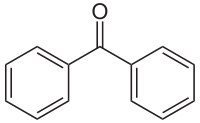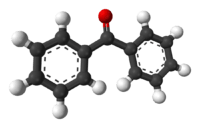Benzophenone
 | |
 | |
 | |
| Names | |
|---|---|
| Preferred IUPAC name
Diphenylmethanone[1] | |
| Other names | |
| Identifiers | |
| 119-61-9 | |
| 3D model (Jmol) | Interactive image |
| ChEBI | CHEBI:41308 |
| ChEMBL | ChEMBL90039 |
| ChemSpider | 2991 |
| DrugBank | DB01878 |
| ECHA InfoCard | 100.003.943 |
| KEGG | C06354 |
| PubChem | 3102 |
| UNII | 701M4TTV9O |
| |
| |
| Properties | |
| C13H10O | |
| Molar mass | 182.22 g·mol−1 |
| Appearance | White solid |
| Odor | Geranium-like[2] |
| Density | 1.11 g/cm3[2] |
| Melting point | 48.5 °C (119.3 °F; 321.6 K)[2] |
| Boiling point | 305.4 °C (581.7 °F; 578.5 K)[2] |
| Insoluble[2] | |
| Solubility in organic solvents | 1 g/7.5 mL in ethanol[2] 1 g/6 mL in diethyl ether[2] |
| Hazards | |
| Main hazards | Harmful (XN) |
| Safety data sheet | External MSDS by JT Baker |
| NFPA 704 | |
| Flash point | 110 °C (230 °F; 383 K) |
| Except where otherwise noted, data are given for materials in their standard state (at 25 °C [77 °F], 100 kPa). | |
| | |
| Infobox references | |
Benzophenone is the organic compound with the formula (C6H5)2CO, generally abbreviated Ph2CO. Benzophenone is a widely used building block in organic chemistry, being the parent diarylketone.
Uses
Benzophenone can be used as a photo initiator in UV-curing applications[3] such as inks, imaging, and clear coatings in the printing industry. Benzophenone prevents ultraviolet (UV) light from damaging scents and colors in products such as perfumes and soaps.
Benzophenone can also be added to plastic packaging as a UV blocker to prevent photo-degradation of the packaging polymers or its contents. Its use allows manufacturers to package the product in clear glass or plastic (such as a PETE water bottle).[4] Without it, opaque or dark packaging would be required.
In biological applications, benzophenones have been used extensively as photophysical probes to identify and map peptide–protein interactions.[5]
Synthesis
Benzophenone is produced by the copper-catalyzed oxidation of diphenylmethane with air.[6]
A laboratory route involves the reaction of benzene with carbon tetrachloride followed by hydrolysis of the resulting diphenyldichloromethane.[7] It can also be prepared by Friedel-Crafts acylation of benzene with benzoyl chloride in the presence of a Lewis acid (e.g. aluminium chloride) catalyst.
Another route of synthesis is through a palladium(II)/oxometalate catalyst. This converts an alcohol to a ketone with two groups on each side.[8]
Organic chemistry
Benzophenone is a common photosensitizer in photochemistry. It crosses from the S1 state into the triplet state with nearly 100% yield. The resulting diradical will abstract a hydrogen atom from a suitable hydrogen donor to form a ketyl radical.
Benzophenone radical anion

Alkali metals reduce benzophenone to the deeply blue colored radical anion, diphenylketyl:[9]
- M + Ph2CO → M+Ph2CO•−
Generally sodium is used as the alkali metal. Although inferior in terms of safety and effectiveness relative to molecular sieves,[10] this ketyl is used in the purification of organic solvents, particularly ethers, because it reacts with water and oxygen to give non-volatile products.[11][12] The ketyl is soluble in the organic solvent being dried, so it accelerates the reaction of the sodium with water and oxygen. In comparison, sodium is insoluble, and its heterogeneous reaction is much slower. When excess alkali metal is present a second reduction may occur, resulting in a color transformation from deep blue to purple:[9]
- M + M+Ph2CO•− → (M+)2(Ph2CO)2−
Commercially significant derivatives
Substituted benzophenones such as oxybenzone and dioxybenzone are used in some sunscreens. The use of benzophenone-derivatives which structurally resemble a strong photosensitizer has been strongly criticized (see sunscreen controversy).[13] Its use in sunscreen has been known to cause coral bleaching via algae blooms, as it washes into the ocean from human use.[14]
Michler's ketone has dimethylamino substituents at each para position.
The high-strength polymer PEEK is prepared from derivatives of benzophenone.
Pharmacological activity
Benzophenone derivatives are known to be pharmacologically active. From a molecular chemistry point of view interaction of benzophenone with B-DNA has been demonstrated experimentally.[15] The interaction with DNA and the successive photo-induced energy transfer is at the base of the benzophenone activity as a DNA photosensitizers and may explain part of its therapeutic potentialities.
In 2014, benzophenones were named Contact Allergen of the Year by the American Contact Dermatitis Society.[16]
References
- 1 2 Nomenclature of Organic Chemistry : IUPAC Recommendations and Preferred Names 2013 (Blue Book). Cambridge: The Royal Society of Chemistry. 2014. pp. 723–724, 726. doi:10.1039/9781849733069-FP001. ISBN 978-0-85404-182-4.
- 1 2 3 4 5 6 7 Merck Index (11th ed.). p. 1108.
- ↑ Carroll, G.T.; Turro, N.J.; Koberstein, J.T. (2010). "Patterning dewetting in thin polymer films by spatially directed photocrosslinking". Journal of Colloid and Interface Science. 351 (2): 556–560. doi:10.1016/j.jcis.2010.07.070.
- ↑ Dornath, Paul John (2010). "Analysis of Chemical Leaching from Common Consumer Plastic Bottles Under High Stress Conditions" (PDF). p. 32. Archived from the original (PDF) on 26 February 2015. Retrieved 26 February 2015.
- ↑ Dorman, Gyorgy; Prestwich, Glenn D. (1 May 1994). "Benzophenone Photophores in Biochemistry". Biochemistry. 33 (19): 5661–5673. doi:10.1021/bi00185a001.
- ↑ Siegel, Hardo; Eggersdorfer, Manfred (2005), "Ketones", Ullmann's Encyclopedia of Industrial Chemistry, Weinheim: Wiley-VCH, doi:10.1002/14356007.a15_077
- ↑ Marvel, C. S.; Sperry, W. M. (1941). "Benzophenone". Org. Synth.; Coll. Vol., 1, p. 95
- ↑ Dornan, L.; Muldoon, M. (2015). "A highly efficient palladium(II)/polyoxometalate catalyst system for aerobic oxidation of alcohols". Catalysis Science Technology. 5: 1428–1432.
- 1 2 Connelly, Neil; Geiger, William (March 28, 1996). "Chemical Redox Agents for Organometallic Chemistry". Chemical Reviews. 96 (2): 877–910. doi:10.1021/cr940053x. PMID 11848774. Retrieved May 14, 2014.
- ↑ Williams, D. B. G.; Lawton, M. (2010). "Drying of Organic Solvents: Quantitative Evaluation of the Efficiency of Several Desiccants". The Journal of Organic Chemistry. 75: 8351. doi:10.1021/jo101589h.
- ↑ Armarego, W. L. F.; Chai, C. (2003). Purification of laboratory chemicals. Oxford: Butterworth-Heinemann. ISBN 0-7506-7571-3.
- ↑ Harwood, L. M.; Moody, C. J.; Percy, J. M. (1999). Experimental Organic Chemistry: Standard and Microscale. Oxford: Blackwell Science. ISBN 978-0-632-04819-9.
- ↑ Knowland, John; McKenzie, Edward A.; McHugh, Peter J.; Cridland, Nigel A. (1993). "Sunlight-induced mutagenicity of a common sunscreen ingredient". FEBS Letters. 324 (3): 309–313. doi:10.1016/0014-5793(93)80141-G. PMID 8405372.
- ↑ Downs, C. A.; Kramarsky-Winter, E.; Segal, R.; Fauth, J.; Knutson, S.; Bronstein, O.; Ciner, F. R.; Jeger, R.; Lichtenfeld, Y.; Woodley, C. M.; Pennington, P.; Cadenas, K.; Kushmaro, A.; Loya, Y. (2015). "Toxicopathological Effects of the Sunscreen UV Filter, Oxybenzone (Benzophenone-3), on Coral Planulae and Cultured Primary Cells and Its Environmental Contamination in Hawaii and the U.S. Virgin Islands". Arch. Environ. Contam. Toxicol.
- ↑ Consuelo Cuquerella, M.; Lhiaubet-Vallet, V.; Cadet, J.; Miranda, M. A. (2012). "Benzophenone Photosensitized DNA Damage". Acc. Chem. Res. 45: 1558–1570. doi:10.1021/ar300054e.
- ↑ Doug Brunk (2014-03-14). "Benzophenones named 2014 Contact Allergen of the Year : Dermatology News". Skinandallergynews.com. Retrieved 2016-06-16.
